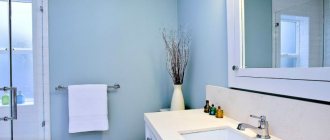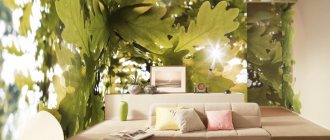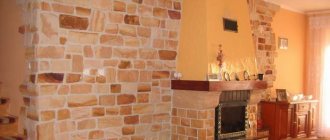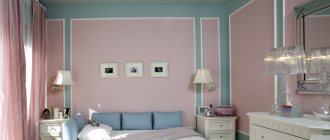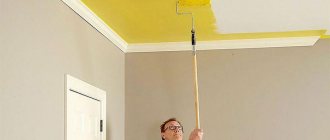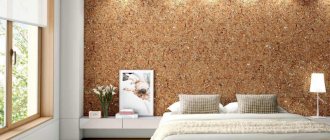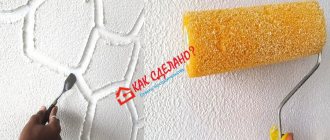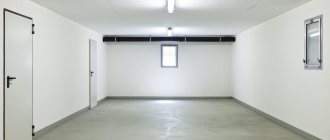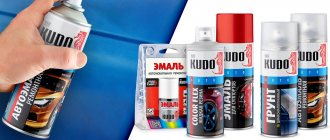wall decor - old walls
Currently, paint as a means of finishing and decorating interior elements has pushed even such popular wallpaper into the background. Is it any wonder, because many options for applying paint allow you to create an original and unique design of the room. And thanks to the availability of the material and the ease of its use, even those who do not have any special knowledge in this area can create decorative effects. Anyone can become an artist! Preparing for work First, you need to decide on your desires and think about what effect and in what place you want to achieve. What paint is best for this? And what else might you need for work. When choosing a paint color, you should remember that dark, muted shades not only create coziness, but also somewhat narrow the space. Cold ones, on the contrary, refresh the room and at the same time visually expand its boundaries. You should also first consider where the light sources will be located. The tone of the paint varies depending on the type of lighting (artificial or natural), and the proximity of the lighting fixtures to the work area. And remember: the larger the size of your creation, the brighter the color will look on it.
A noble trace of time: antique design
Agree, columns, candelabra and excess gilding look ridiculous in our cramped standard apartments. It’s stupid to try to fill small rooms with the decoration of palace halls - let’s leave European-quality renovations of the 90s “under the classics” aside.
But it is possible and necessary to introduce light touches of history into a modern, contemporary interior - this will make the house more interesting, as if you are giving guests a casual hint of your intelligence and good taste. Let the living room be decorated with grandfather’s crystal chandelier or even a small, actually antique table: a small detail should attract attention.
It’s important to remember here: vintage is not a one-to-one recreation of an era, it’s a rethinking of it. Elements that have aged well should be successfully woven into modern design. You don't want to live in a dusty museum, do you?
Here's the main secret of a vintage interior:
- 1-2 actually old or vintage items;
- 2-3 artificially aged;
- the rest is fundamentally modern.
Moreover, the elements are not only furniture. Lamps, textiles, art, even a roll of vintage wallpaper, perfectly preserved in the attic, can work wonders. If only the old, aged and new combine well and play off each other.
And if everything is clear with the first point - you will take something from your grandmother’s inheritance or buy it at a flea market (or maybe really in an antique store), then you need to talk about aged interior elements separately.
Aging methods
Faded colors and patterns, elegant cracks, fading, light patina, wear and tear - all this beauty can be artificially imparted to objects using special aging techniques.
Patination
Remember the greenish coating on copper surfaces? This patina is the result of oxidation that forms on some alloys over decades. With the help of chemical compounds or simply artistic imitation, the process of patina formation can be significantly reduced. Modern materials make it possible to create this effect not only on copper surfaces.
Rust
Self-oxidizing metal panels have already become a fashionable trend in exteriors, and nothing prevents rust from being used inside homes as well. Special solutions allow metal to become covered with red-orange traces of rust in just a couple of hours. And decorative rust-look coatings will give the walls a fashionable effect without sacrificing comfort.
Limescale
This effect is most often used to give wood a dusty look. Special suspensions lighten the fibers, making wood surfaces look older.
Craquelure
Noble cracks are imparted to surfaces using compounds applied on top of a decorative material or between 2 layers of paint of different colors. You can vary the thickness and method of applying the composition, achieving bolder breaks or, conversely, thin, neat cracks.
Abrasions and mechanical stress
The fashion for luxurious shabbyness has passed into a separate interior style - shabby chic.
Aging paint
There are many ways to age a painted surface besides craquelure. The craftsmen apply it “not according to the rules”, achieving rapid crumbling, removing the top layers of paint - all to make the wall look a little frayed and careless.
Aging wood
To age wood, they use either the usual glazes and oils, which more clearly reveal the natural structure of the wood, or they do brushing - mechanical removal of the soft fibers of the wood. What could be more noble than old wood?
How to age walls: decorative plasters
Is it worth reinventing the wheel by trying to age the walls if there is decorative plastering? Almost all of the effects described above can be created using plasters and glazes included in the kit. And not only walls: some decorative materials, for example Plasma 3D, can be applied to the surface of floors, furniture or, say, household appliances. The effect of shabby metal, peeling paint, rust, craquelure - all this is easily done with the help of decorative plasters.
Worried that plastering is expensive, difficult and inappropriate? We have already smashed myths about decorative plasters to pieces more than once; re-read this article if you are tormented by doubts. And if you have questions about how to select and how to work with this material, contact Loggia specialists for free.
Make your interior more soulful: a couple of vintage items or finishing elements will always find a place even in the most modern interior.
Aged walls • DECOR interior walls with paint (+photo)
wall decor - old walls
Currently, paint as a means of finishing and decorating interior elements has pushed even such popular wallpaper into the background. Is it any wonder, because many options for applying paint allow you to create an original and unique design of the room. And thanks to the availability of the material and the ease of its use, even those who do not have any special knowledge in this area can create decorative effects. Anyone can become an artist! Preparing for work First, you need to decide on your desires and think about what effect and in what place you want to achieve. What paint is best for this? And what else might you need for work. When choosing a paint color, you should remember that dark, muted shades not only create coziness, but also somewhat narrow the space. Cold ones, on the contrary, refresh the room and at the same time visually expand its boundaries. You should also first consider where the light sources will be located. The tone of the paint varies depending on the type of lighting (artificial or natural), and the proximity of the lighting fixtures to the work area. And remember: the larger the size of your creation, the brighter the color will look on it.
How to paint antique.
Today, antique painting is popular in interiors. The walls and furniture are given the effect of a noble antique finish. Such decoration will help to fit things into the overall interior, made in retro style. There are many ways to paint antique surfaces. To get started, just master a few design tricks.
Primer for paint
Artificial latex paint
Long bristled brush
Bronze, gold and green paints
Prepare the wall for antique painting. First you need to clean it of dirt. There is no need to putty - just apply a special primer under the paint. Let it dry for 4 hours.
Buy paint that contains artificial latex. Choose a brush with long bristles. Start painting the walls in a circular motion. Press the brush onto the surface from time to time: “scuffs” will appear.
Scrub the painted and dry wall using a brush, sponge or sandpaper. The “time pattern” on the wall depends on your movements.
Let the wall dry completely. Then use a sponge to apply technical wall wax in two layers. Polish each dried layer with a soft cloth. The wax will dry for about 6 hours at room temperature. As a result, you will get a shiny wall with “antique” scuffs.
Antique paint your wood furniture. Old layers of drying oil, paint or varnish must be removed with sandpaper and solvent.
Choose a paint that suits your retro style. For example, bronze or gold. You can make 3 layers: green, bronze and green again. When the paints are dry, rub the top with coarse and then fine sandpaper.
Wait for the decorative layer to dry completely and cover the furniture with a special crackle varnish (“craquelure”). This is a product that cracks when it dries, creating interesting cracks. It is necessary to apply one type of varnish first, and then (when your hands stop sticking to the surface) another. The components of these two layers do not fit with each other, which is why an intricate web of cracks is obtained - crackle. Carefully read the instructions for varnishes No. 1 and No. 2.
Cover the cracks with grout to make them look more contrasting. Apply a bitumen patina to the varnished surface with a sponge - it is specially produced for the crackle technique. Your task is to rub the grout into the cracks and remove the excess with a rag soaked in vegetable oil.
Wipe the “aged” furniture with a towel, let it dry and apply any fixing varnish to it.
You can “aging” walls and furniture beautifully only if you have mastered this skill well. First, treat a piece of wood or an inconspicuous corner of the wall. Then decorate the interior in retro style. Now, if you wish, you can make the facade of the building using the same technique - all the decorative materials necessary for this are resistant to the environment.
When working with craquelure varnishes, rub the cracks very carefully! They are extremely fragile. If you want the web of cracks not to stand out too much, dilute the grout with white alcohol.
You can do without additional paints. Just buy two types of crackle varnish and bitumen patina from a specialized artist store. The first number of craquelure varnish with an amber tint is decorative in itself.
Decorative antique metal painting and more
Metal is widely present in our premises, and is used where its unique physical properties compared to other materials are needed. However, metal often also decorates the living area with its presence.
And in order to make its visual characteristics even more interesting, the metal surface can be given a particular color or texture.
Metal painting itself is most often done for protective purposes, but the decorative painting technique has many differences.
How to show patina
Patina is a characteristic greenish coating that appears on the surface of copper and bronze products after oxidation. At the moment, the best way to show this effect is WS-Patina paint. In this way, it is possible to age the metal and give it a characteristic respectable shine.
Antique painting
One of the most popular ways to paint black metal is the antique effect. In this case, several coating options are applied to the metal surface in a certain order.
But first, the metal itself must be properly prepared. It must be cleaned of corrosion, sanded, and dirt and grease are removed.
Only when you are confident that the surface is clean can you begin the process, which is divided into several stages:
- Using a brush, apply metallic paint to the surface. Don't be afraid to do it casually, as this will only help with the effect we are creating;
- Once the first layer has completely dried, it is necessary to apply a craquelure primer. The latter allows you to obtain a layer of transparent film created from polymers;
- The craquelure coating is applied after the primer layer has dried, which allows you to get characteristic cracks, similar to those that appear on things that have been used for decades and even centuries.
Important! Instead of a craquelure composition, the effect of antiquity can be achieved by applying burnt umber to the paint. In this case, it is best to work with a dry cloth, and remove the residue after the paint layer has dried.
Bronze metal painting
Bronze coating is one of the most visually impressive. Therefore, people often strive to recreate it. And there are several ways to do this, and they all involve the use of bronze paint.
First of all, the surface is prepared. Dirt, grease and rust are removed. After this, a layer of metal primer is applied to it, which will increase the adhesion of the layers applied above. At the third stage, bronze metallized paint is applied in 2-3 layers.
If you want to give this bronze layer the effect of antiquity, then the recesses must be treated with patina, which allows you to get the effect of darkening over time. After this, glazing is carried out, during which we go over the protruding elements and those places that are characterized by abrasions with white paint. After the latter has dried, a transparent varnish is applied to seal the effect.
Conclusion
Painting for all other types of metals occurs in a similar manner. Modern metallic paints allow you to create the effect of brass, copper, silver, gold and other metals.
Don’t be afraid that you won’t succeed. Practice shows that such methods of metal processing are feasible without any serious knowledge. The video tutorial below will give you comprehensive information on this matter.
How to age walls, wood or metal by painting?
If you are a lover of old things or you simply have nothing to update the interior of your home, you can easily use the antique painting method. A large number of things are suitable for antique painting. This includes furniture, walls, and doors. In general, everything that gives your home a certain style.
Nowadays it is very difficult to buy antiques or furniture, and it is also expensive, which not everyone can afford. After all, previously all wood products were made mainly from oak or other massive types of trees. Therefore, the average income that the majority of the country’s population has is not enough to purchase them.
And only antique painting is an excellent and fairly budget-friendly way out of this situation. In addition, there are a huge number of methods and processing techniques that allow you to achieve an excellent aging effect with your own hands.
Some features and recommendations
When working, it is important to use only high-quality tools. It will allow you to achieve the maximum effect of antiquity. You should not abuse innovations. Every design decision has the right to exist. This also applies to the antique painting process. It is not necessary to use such techniques only in this form. You can achieve other effects appearing on the wall. Antiquity is simply one of the varieties and possibilities that do not necessarily have to be applied. Exactly the same movements on the paint can be used to create other drawings. This is a creative process that should help people realize what they are capable of.
Every person is capable of much. There is no doubt about it. If you create the effect of antiquity in your home with your own hands, then you can safely say that a person has learned to create. This is only a small part of the abilities that he can demonstrate at various stages of his development.
When the work is completely finished, you can decorate the wall with some decorative elements. These can be massive paintings, which will further enhance the effect of antiquity. An excellent solution for most modern apartments.
Painting the walls
It is from this important stage that the transformation of your room begins. And the quality and further appearance of the room depends on it. First you need to clean the surface of dirt, and most carefully walk along the partition. After processing, there should not be the slightest speck of dust or old coating left on it.
All previous material from the wall must be removed so that it does not interfere with further work. It is best to use a spatula for this. In addition to this, prepare:
- paint;
- sponge;
- brush;
- primer for paint;
- sandpaper;
- brush;
- technical wax for walls
The source material is a pure wall, ready for any flight of fancy, even the most impossible.
Next, you will need a special primer, which can be purchased at any store. After diluting it, you should not wait, but immediately apply it to the surface of the wall, as it tends to harden. After the primer has completely dried, you can begin painting.
The paint must be selected in advance, and one that contains latex. This particular paint is ideal for walls and is resistant to fading. Buy a brush with long bristles. The paint should be applied in a circular motion. Moreover, periodically you need to put pressure on the brush, as a result of which a scuffed effect will be created. It will be the main sign of antiquity.
But that is not all. After all, painting the walls does not end the job. After this, it needs to be properly rubbed. To do this, you need a brush with which to rub. Instead of a brush, you can use sandpaper or a sponge. The pattern of the antique will depend entirely on your movements with the brush. You can use all your imagination. In this case, experiments are encouraged.
After waiting for the wall to dry completely, you can apply wax to it. It is applied using a sponge. Then, after waiting a few more hours, you can enjoy the fruits of your labor. All DIY antique wall painting is ready.
Antique brick painting technology
It is easiest to paint a brick wall antique because the material itself has an old-fashioned appearance. Next, we’ll look at the process of how to paint antique brick surfaces. It is necessary to apply an acrylic paint composition of the required shade to the bricks. The difference lies in the unique method of applying paint.
Before painting a brick surface, you need to prepare a sponge and a coloring compound of the required shade. Antique-looking brick painting is done with light, effortless movements, spreading acrylic paint over the surface.
To enhance the antique effect, a brick wall requires grouting the joints with regular earth or painting it in your preferred shade.
Painting wooden products
If you want to paint a wooden surface, be it a wall, a door or furniture, then first you need to treat it. First you need to remove the old coating from the wood. After this, the wood needs to be cleaned and sanded with sandpaper, starting with coarse sandpaper, gradually selecting finer ones.
Then be sure to cover the treated wood with an antiseptic primer, which will protect the wooden surface from mold and rot.
To age wood, you need to use a special painting method:
- Apply the first coat of paint. For this it is better to use matte acrylic.
- After complete drying, sand the paint.
- A second coat of paint is applied in a thin layer.
- To age the wood as much as possible, you can rub individual areas with sandpaper again.
- Finish the work by sanding the entire product with fine-grained sandpaper.
The process of painting antique wooden products with your own hands is over. This painting method can age both furniture and doors.
Craquelure
There is another way to age wooden products with your own hands. It's called craquelure. It is achieved by creating fine cracks in the varnish. You can achieve this like this:
- Apply a layer of paint of the desired shade to the previously cleaned surface. This is the color the cracks will be.
- After it has completely dried, apply a transparent varnish - craquelure.
- When the varnish dries, apply another coat of paint in a color significantly different from the previous one. After which the varnish will begin to crack.
- To complete the paint job, coat the wood with a regular clear varnish.
Patina
Another way to age wood is patina - a special paint applied to any wooden product. It's very simple - apply a varnish based on polyurethane or polyester to the surface of the wood. A thin layer of patina lies on it.
After waiting for complete drying, treat the product with a metallic sponge. The aging effect depends on the intensity of treatment. At the end of the work, everything is varnished.
Features of painting doors
The door painting process has some features:
- first you need to remove all the old paint with a spatula;
- unscrew hinges, locks, handles and other existing parts;
- Wash the entire surface of the door to remove accumulated dirt and dust;
- sand the door using sandpaper;
- Carefully fill all cracks and scratches.
If the preparation process is completed, you can proceed directly to painting. First, decide on a color. After obtaining the desired color scheme, cover the entire surface of the door with stain. To do this, take a swab and cover the wood several times until you obtain the desired shade.
To give the item an antique look, add scuff marks to the corners, keyhole, and handles. This can be done using a wire brush. After this, cover the entire surface with colorless varnish in several layers. Once the door is dry, reinstall all removed hardware.
Metal paint with aging effect - Doors, partitions
When painting metal products, two goals are pursued: protection against the formation of corrosive areas and giving the metal an aesthetic appearance. When implementing the last task, sometimes it is necessary to cover the surface in 2-3 layers.
But the end result may not always be just painting. Sometimes metal products need to be given original decorative effects, for example, the appearance of an aged object. For this purpose special technologies are used.
Let's try to figure out how to paint antique metal and what is required for this.
Aging materials
You can achieve the effect of aged metal by using the main method - aging through the creation of a patina and the formation of abrasions.
Patina is applied with special paints, but for metal, acrylic-based metallic compounds are more often used.
In stores today there is a wide range of such paints; in addition to their decorative function, they also perform a protective function.
There is a choice of acrylic paints for aged metal, namely:
- brass;
- bronze;
- copper;
- gold.
Thanks to modern technologies, an aged effect can be given not only to metal surfaces. Often this painting is performed on plastic, wood and plaster products.
The aging process is completed by applying a final protective layer. For this they often use:
- acrylic-based varnish, which has a high degree of gloss;
- very durable polyurethane-based varnish with a gloss level of up to 50%;
- polyurethane-based varnish with a matte effect.
How to age metal yourself?
The choice of method for creating an interior style, which assumes the presence of traces of antiquity in the design, is quite wide. For connoisseurs of this style, it is not always affordable to purchase real old items. The way out of this situation is to imitate ancient metals. How to properly paint antique metal with your own hands? Coloring is carried out in stages:
- Preparing the surface for painting. We get rid of dirt, rust and traces of grease by grinding and solvent treatment.
- Metal priming. In this way we achieve the formation of roughness on the surface for better adhesion of the paint. We choose a primer special for metal.
- Application of selected metallic paint. Experts advise performing the process using a regular brush, this way aging is achieved in the best possible way.
- Aging stage. When the paint has dried, coat the surface with a special craquelure varnish. It is after this step that the metal object becomes covered with cracks, which create the effect of an old product.
Important! If non-metallic surfaces are being processed, then it is necessary to take a responsible approach to the choice of primer composition to achieve reliable adhesion with metallized paints.
On video: master class on applying patina to forged metal.
Bronze painting
In the old days, many objects were made of bronze. Therefore, painting products in bronze will help to decorate the interior of the house in an old style. There are several technologies for coating metal with bronze. Let's consider the simplest options.
Giving a monochromatic effect
You can perform a single-color coating of metal with bronze as follows:
- First of all, we clean the old surface from dirt and rust. To do this, you need to clean it with sandpaper and then degrease it.
- To increase the adhesion of the dye to the surface, we perform a metal priming process. In addition to adhesion, the primer will help further protect the product from corrosion.
- At the final stage, we begin painting with bronze paint. It is necessary to apply 2-3 layers evenly. But each subsequent layer is applied only after the previous one has completely dried.
Achieving the effect of antique bronze
Decorative antique painting with a bronze effect is suitable for lovers of rare things. To do this, follow these steps:
- Preliminary preparation of the old surface is carried out according to the same rules as in the previous case. Also, do not forget to coat the product with a primer.
- After priming, one layer of bronze paint is applied to the surface. It is desirable that the composition be applied evenly, but for an antique effect it is better to use a brush.
- After drying, the bronze painted surface becomes covered with patina (paint of a darker color). It is applied to the recesses. Experts advise using a translucent patina. This allows you to adjust the shade of the bronze coating.
- The next stage is glazing, that is, processing with a brush that is barely moistened with light paint. The process is carried out on all protruding edges and corners. This aging method allows you to give the product the effect of wear and tear, which usually appears on metal over the years.
- Next, we wait a while, allowing the applied materials to dry completely, and finally we coat the product with transparent varnish.
Antique Brass Painting
Textured metallized compositions can transform a product, giving it an imitation of brass. The processing technology is almost no different from those provided above. The surface is pre-cleaned, sanded and degreased. For aging, a technique of decorative painting to imitate brass is used.
The application process is carried out as follows:
- Before applying decorative paint, the old coating is removed from the product. To do this, you can use a wire brush or sandpaper.
- The key to durability and reliability of painting is the primer. Use a compound specifically designed for metal.
- Brass paint is applied to the surface in one layer. You can age the resulting coating by painting it with craquelure. Burnt umber, which is applied very carefully using a dry cloth, will help enhance the effect. If excess is formed during the work, it must be removed before the substance dries.
- Finally, the surface of the painted and aged part is coated with a glossy acrylic-based varnish.
As you can see, designer antiquity is achieved in simple ways. When doing work with your own hands, paints that create the necessary effect of a bronze, brass, or copper surface help you get the desired result.
Possibilities of metal patination (24 photos)
Decorative antique metal painting and more
Metal is widely present in our premises, and is used where its unique physical properties compared to other materials are needed. However, metal often also decorates the living area with its presence.
And in order to make its visual characteristics even more interesting, the metal surface can be given a particular color or texture.
Metal painting itself is most often done for protective purposes, but the decorative painting technique has many differences.
What metal products do we paint most often?
Various metal objects, lamp caps, heating radiators, sinks and similar elements are most often subject to painting with decorative properties. In this case, work can be carried out both on objects used indoors and on external metal elements.
Advice for those who are planning to paint a metal surface at sub-zero temperatures
Although this advice may apply more to ordinary painting than decorative painting, situations are different. For example, you need to immediately paint a part that has just been brought in from the cold. Therefore, we will give some tips:
- The best way to paint in cold weather is to use alkyd enamels with a jelly-like consistency that have high adhesion (the ability to penetrate the surface structure);
- Painting a surface cooled to temperatures below +5 degrees Celsius should be done exclusively with preliminary treatment of this very surface with a torch or heat gun. Otherwise, condensation will form on the surface on which the paint simply will not adhere;
- If the room itself is cold when painting, the drying time of the layer can increase several times, which is especially unpleasant for decorative painting. Therefore, it is recommended to install a heat gun and cover the surface with film.
What are blacksmith paints
Recently, forging paints, specially optimized for working with forged materials, have become very popular. Such paints are applied to forging for decorative purposes, which makes it possible to imitate a wide variety of surfaces, from gold to cast iron.
The cost of such paints is higher than that of ordinary ones. However, this is due to their increased shelf life, which reaches 5 years or more. At the same time, such paints also look really impressive, allowing you to give the required visual effect by the very fact of their presence. Without the need for different painting methods.
Today there are many types of such coating, but the most popular is the German WS-Plast paint, produced by Weigel & Schmidt GmbH. These paints allow you to give metal surfaces a variety of different colors and textures.
Here you will find emerald color, graphite with red tones, and various types of antique painting. Moreover, such a coating not only decorates, but also protects the metal surface from corrosion and other troubles caused by the influence of nature.
Painting of metal products
This technology is less in demand, since there are much fewer metallized products than wooden ones. Therefore, to age the metal, you can also resort to craquelure treatment. And to make the effect more pronounced, you can highlight the resulting cracks with burnt umber. It must be applied to certain areas before the composition dries completely. A prerequisite is that the umber should only be on the cracks.
Considering the fact that the color range of metal is very diverse, the surface can get a shade from gold to brass. Therefore, when it is processed with craquelure, it takes on an ancient look, and maybe even antique.
To achieve the aging effect, you must first coat the product with metallic paint. Then a primer layer of craquelure is applied, strictly following all instructions, without smudges and in an even layer. After it dries, apply the first layer of craquelure with a brush. When it starts to dry, small stripes will appear on the surface.
The thicker the varnish layer, the larger the cracks. Finally, coat the surface with a layer of clear varnish.
In conclusion, we can conclude that antique painting can be applied to any surface of different ages and conditions. The main thing is to have a desire to do everything with your own hands and imagination. Create, and the result will not keep you waiting.
Decor
Now you can proceed directly to the decor. Creating decorative effects There are a great many techniques to diversify a boring monotonous surface. With their help, you can create either a fairly calm striped wall or erect reliable brickwork. Using various tools, you can paint a romantic starry sky on the ceiling of your bedroom or decorate part of the living room wall with imitation crocodile skin. The possibilities of paint and methods of applying it are almost limitless! The simplest of decorative painting techniques is decorating with a rolling effect. The essence of this method is to apply darker or brighter paint using a special shaped roller onto a lighter and calmer first layer. In this case, glaze and often artistic paints are added to the paint to apply the pattern. Various stencils are used in the same way. On the first dried layer, by applying a stencil to it, a pattern is applied with paint of a different color. You can make such blanks yourself by transferring the pattern you like onto the surface of the future stencil and cutting it out along the contour.
Imitations of various textures
- The effect of a wooden texture is also achieved quite simply. First, the surface is painted with the first, lighter layer of paint. Then another layer of darker paint mixed with glaze is applied. And then, using a dry brush, remove excess glaze with vertical movements. In this case, veins are formed that resemble the structure of wood.
- marble looks very nice . The application technique is quite complicated, but the effect is worth the effort! The first layer of white emulsion paint is applied to the work surface. After it has completely dried, use a 2.5 cm wide brush to apply two slightly darker colors of glaze using random strokes. While the glaze is still wet, use a texturing brush to blend both colors. Next, using a wide soft brush, smooth out any rough color transitions left after work. The movements should be light. Then the marble veins are drawn with a thin artistic brush and also shaded with a soft brush. After complete drying, the drawing is processed with fine-grained sandpaper and varnished. The incomparable marbling effect creates a mood, changing depending on the lighting.
- The effect of an old wall is achieved primarily by old, half-dried, shabby materials. The roller should be dry, as if they forgot to wash it and the paint has thickened in the bath. It is better to paint mixed with different rollers with different shades.
Antique decorative plaster
There are things and phenomena that do not leave a person indifferent. One of these phenomena is time. Antique objects can charm you with the traces left on them by time. Therefore, antiques are valued not only for the skill of making things, but also for the flair of time. If there are no ancient walls, you can always create an imitation of the veil of time artificially. Antique plaster is used for this. Manufacturers offer special compositions for creating interiors that recreate the atmosphere of the distant past. This material is used in the interior of residential premises, cafes, restaurants, and other public places. House facades can also successfully “age”
Effects, advantages and disadvantages
The effect of time can be expressed through the texture of the surface or using special painting techniques. Antique decorative plaster combines both of these techniques, because it contains artificial latexes, which give the surface a special roughness when drying and tend to become lighter in places of greater friction. The microporous film formed during drying also protects the coating surface from high temperatures and mechanical damage.
The advantages noted by everyone include:
- versatility of application (facades and interiors),
- possibility of use in places where humidity does not allow the use of other types of plasters,
- high strength,
- fire resistance,
- excellent environmentally friendly qualities,
- easy to care for – can be washed with detergents, excluding those containing organic solvents,
- durability.
As for the disadvantages, these include, first of all, the difficulty of working with some textures, for example, antique Venetian.
Tools and surface preparation
The following tools and devices will be useful:
- spatula (stainless steel, plastic),
- trowel (for applying the composition and structuring the surface),
- roller for priming and painting,
- brush,
- sponge,
- rags.
For a coating that has an antique effect, the base for decorative plaster is prepared according to the technique by which this effect will be achieved. If the mixture is applied in a layer of 3 mm and structured using the touch-touch method, then minor cracks or unevenness in the base of the finishing painting will not spoil it. And if the antiquity is imitated by the Venetian, then the base must be leveled and prepared especially carefully. In any case, the base must be degreased, clean, level and dry. It is coated with a deeply penetrating primer, and then with a primer composition, the components of which include quartz sand or fine-grained marble chips. The ground covering must be dried.
The more professional the tool you use, the easier it will be for you to work, and the result will be noticeably better.
If a solution with an antici effect is used, then two layers of primer paint are applied with a roller, and it is better to take the color two shades lighter than the future finishing coat.
Preparing walls for decor
Having made your choice, start preparing the surface for decoration. The easiest thing is if your “canvas” has already been previously covered with paint, and it is in good condition - without chips, cracks or other troubles. In this case, it is enough to thoroughly degrease and wash the desired area. If the walls are covered with wallpaper or decorated with any other materials (for example, tiles, panels), then before starting work it is necessary to remove them and putty the surface.
For the effect of antiquity, as in our case, careful preparation is not necessary; on the contrary, you can deliberately leave roughness, unevenness and add texture in places.
Application technology
The antiquity effect can be achieved by using:
- craquelure plaster (the use of which will give a wall covered with cracks),
- special composition of plaster with antique effect,
- special technique for applying a structural composition.
Some people consider the decorative plaster of the world map to be antique. Since it supposedly imitates a coating that has peeled off over the years. But the author of the article has the opposite opinion on this issue.
Three techniques that, using decorative plaster, create the effect of antiquity.
- Craquelure. First, acrylic paint is applied to the primed wall with a roller in an even layer. After 4-6 hours, apply craquelure varnish with a brush or roller. The main direction of future cracks depends on the movement of the tool during the application process. The movements of the roller can be horizontal or vertical or alternately in different directions. The thickness of the varnish layer determines the depth of the cracks that form when it dries. Different types of varnish can dry from 40 minutes to 2 hours. A layer of Venetian or structural plaster up to 2 mm thick is applied to the dry varnish with a wide spatula. The movements are made in different directions. Instead of plaster mixture, you can use acrylic paint (thickness - 1 mm), applying it with a roller. The layer dries quickly, cracks begin to form after five minutes, so it must be applied quickly. Apply the layer in wide vertical stripes, trying to avoid smudges at the joints. Complete drying in about a day.
- Composition of Antico paretto (old wall). The mixture, consisting of a transparent base, contains insoluble mineral inclusions that are crushed during the application process. The mixture can be tinted. The untinted mixture is applied to a colored substrate. The mixture is applied to the wall with a trowel in multidirectional strokes in a thin layer. Depending on the force of pressing the instrument, either prominent white spots or whitish stains are obtained.
- Antici plaster. Like all other ready-made formulations, the mixture is stirred before use. It is applied to the wall crosswise with a flat brush using short strokes. Having applied the mixture to the treated area of 1 or 2 m2, begin to smooth it. To do this, use a plastic spatula. Smoothing the wall with multidirectional movements, distribute the inclusions contained in the mixture over the surface of the wall.
- Antique structural plaster. The effect of an aged wall is obtained by forming the surface texture of a laid layer of structural plaster with fibers. First, a layer of the mixture up to 3 mm is applied with a trowel (the thinner, the finer the pattern can be obtained after texturing). After application, the formation of texture begins. Only the part of the working surface of the trowel close to the edge of the end is involved in the work (the rest of the working surface of the trowel is not involved in the process). Having applied a little solution with a spatula to the working area of the plane, it is lightly “glued” to the surface and slightly raised above the layer of solution, without letting it come off. The solution is drawn behind the tool and can be shaped by moving the trowel in an arcing, chaotic motion. Due to the fibers of the mixture, the mass stretches very strangely behind the tool. After half an hour, when the surface of the solution has stuck a little, it is smoothed with a clean trowel. When the wall is dry, all sharp roughness is smoothed off with sandpaper. Dust is removed with a brush.
Antique painting of wood, metal and other materials
Light antique painting is a fairly popular operation when creating various interiors. It is traditionally believed that antique items add an element of sophistication and luxury, emphasizing the style and wealth of the owner of the room. However, genuine antiques are highly expensive and often require restoration and special care.
It is much easier to simulate the aging of an object. And today this art is mastered not only by artists, but also by painters and simply amateurs. So, it will be quite possible for you to paint antique furniture if you set yourself such a task. But before you tackle your great-grandmother's chest of drawers, practice on something less valuable.
Methods for aging wood and other materials
There are several ways to age furniture and other types of materials:
- application of special compounds that change the appearance and properties of the top layer of coating (available for wood and metal work);
- painting with several paints of different colors so that the lower layers show through the upper ones;
- processing with sandpaper and other abrasive materials;
- the use of pigments that create the illusion of aging and some dirt.
Painting wooden elements
The most ordinary things can be turned into decorative furniture or accessories that are not inferior to antique items in terms of sophistication and the ability to create a special atmosphere in the room.
The question of how to paint antique wood arises when you want to make original and sophisticated-looking details using existing interior elements.
Antique painting of wood is quite possible at home; all you need is the most common tools. Before painting, it is necessary to carry out preliminary preparation of the object to be decorated.
Before aging a product, several stages of work are carried out:
- The surface of the object being processed is cleaned. Varnish, old paint, and any other coating are removed from wood. Those parts and fittings that are not planned to be painted are dismantled.
- The surface is polished and then cleaned from dirt and dust.
- The surface is primed with antiseptic compounds to avoid subsequent rotting or mold damage. The primer will also ensure the paint adheres better.
It is not recommended to use putty when preparing to age wood. With this design solution, the emphasis is on the presence of small defects in the wood, so you should not completely mask the flaws.
Creating the effect of dilapidation and wear
Artificially giving wood a shabby and dilapidated look is called brushing. The production uses sandblasting, during which soft fibers are removed from the top layer, causing the structure of the wood to become more pronounced.
When processing antique wood in a similar way with your own hands, the surface is first covered with matte acrylic paint. After it dries, abrasions are formed using a metal sponge or sandpaper, while individual areas can be affected more intensely to obtain a more natural look. The product is cleaned and a second coat of paint is applied.
At the end of the processing, it makes sense to go over the wood with a fine-grained abrasive tool.
Without using paint, you can achieve the effect of antiquity by painting wood with stain. This special material stains the wood by penetrating into its outer layer.
During absorption, the stain colors the wood in its natural color, while emphasizing the texture. There are also colorless compositions that perform exclusively protective functions.
The stain is applied with a cotton-gauze swab - a piece of cotton wool is wrapped in folded gauze. The composition is poured into the cotton wool so that it saturates it, but does not leak out when you press the tampon. Then the stain is rubbed over the entire surface. The process is repeated several times.
Sandpaper creates abrasions on the treated surface. The result is a natural wooden plane with pronounced texture and wear, characteristic of antique interior items.
Using a special varnish coating
To create a surface cracked by time, craquelure compositions are used, forming a coating on the product with a characteristic pattern in the form of uneven violations of the integrity of the paint layer.
This technique is called crackle; the “aging” of the product is carried out as follows:
- The product is cleaned and the surface is covered with a layer of paint. Please note that cracks in the final coating will have the same color as the first coat of paint.
- The dried paint is covered with craquelure varnish, which must be applied in one direction. A transparent film will appear on the surface.
- A base layer of paint of the desired color is applied over the craquelure varnish. This layer cracks under the influence of the craquelure composition, and the entire surface takes on a characteristic appearance with small cracks.
- To protect the aged surface, it should be coated with a transparent varnish.
Patina coating
To imitate the oxidation process characteristic of products made from certain metals, patina paint is used. This creates a rather interesting and unusual image of wood with the effect of antiquity and the color of bronze.
In order for a wooden object to acquire a specific antique look, its surface is first varnished to increase strength and wear resistance. When the varnish is dry, a thin layer of patina paint is applied to the surface.
After 30–40 minutes, the treatment is carried out with an abrasive tool, sandpaper or metal sponge. The effect increases with increasing intensity of such treatment.
Using a cloth, the resulting dust is removed, and the product is treated with transparent varnish.
Painting in several layers
With the help of multi-layer coloring, the effect of an aged object, which was previously often repainted, is achieved. This antique painting of furniture is based on the factorial characteristics of wood and color differences.
The selected primary color is applied to the surface. This layer should be thin, so that the wood pattern is clearly visible. An abrasive tool creates abrasions and the product is painted with a second color. This layer is applied with light, careless strokes.
For additional realism of the color, in some places the second layer of paint is shaded so that the main background appears.
Aging of metal
New metal parts do not always fit into a sophisticated and thoughtful interior, primarily due to the presence of a characteristic shine. The use of antique metal objects is not available to everyone, so it is more advisable to artificially create the effect of antiquity using imitation paints or special surface treatment.
https://www.youtube.com/watch?v=zptNY-j7hss
You can paint antique metal with your own hands sequentially as follows:
- The surface of the product is degreased and treated with a primer to improve the quality of subsequent painting.
- After the primer has dried, the product is painted over with metallic paint.
- When the paint is completely dry, it is evenly treated with a craquelure primer, which forms a transparent polymer film during the fixing process.
- The surface treated with this primer is covered with a craquelure composition, which adds characteristic cracks and gives the metal product the appearance of an antique item slightly touched by corrosion.
In addition, to give metal an antique effect when painting, you can use various pigmenting compounds. For these purposes, umber is often used, a mineral pigment that is resistant to light and alkalis.
Burnt umber is applied in a small amount to a piece of fabric and rubbed into the painted surface. The pigment remaining in the cracks of the coating completes the look of the antique item.
Painting brick walls
Brick itself often has a rather retrograde look, so painting such antique walls seems to be the simplest and is done by covering it with acrylic paints in the desired colors. Antique brick painting differs from conventional painting by a special method of applying acrylic.
Acrylic paints are applied with a sponge, which is dipped in the desired color. The bricks are painted one by one with light and gentle touches of a sponge. To enhance the effect, the space between the bricks is painted with a different color or the seams are darkened before painting.
Antique painting will allow you to breathe new life into ordinary and boring objects. Experimenting with various coloring compositions and technologies for treating the surfaces of walls, furniture and various decorative elements will allow you to get an impressive result without significant financial costs.
Consumption and coloring
The craquelure obtained with a layer of acrylic paint, after drying, is covered with varnish or protective wax using a sponge. If the craquelure is obtained with a structural mixture, its surface is slightly sanded with sandpaper, after which the dust is swept away with a brush. Finally, the finish is coated with wax.
The structural coating is lightly sanded, then coated with a tinted varnish using a sponge using a brush or long-haired roller. Excess varnish is removed with a sponge passed over the top of the protruding relief. This lightens the top of the relief, and the result is antique plaster.
Painting with a silver or gilding effect looks good in classic interiors.
Since application techniques are different, the consumption of the compositions will also be different. For a thin coating, the consumption for craquelure is from 100 g/m2. The consumption of structural plaster for the fourth technique is up to 0.8 kg/m2 (depending on the thickness of the layer).
